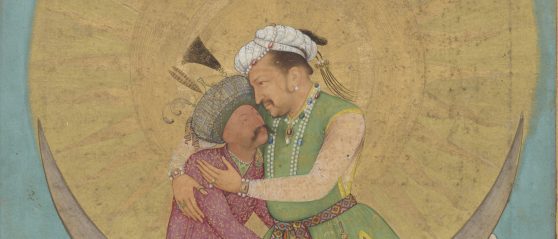July 28, 2012–September 16, 2012
-
Dates
-
Location
Arthur M. Sackler Gallery
-
Collection Area
South Asian & Himalayan Art
India’s Mughal emperors, who reigned over a vast and wealthy empire that extended from Kabul over most of the South Asian subcontinent between the sixteenth and the nineteenth century, were passionate about lavish manuscripts and paintings. Between 1556 and 1650, the greatest Mughal patrons—the emperors Akbar, Jahangir and Shah Jahan—formed grand workshops that brought together and nurtured India’s leading painters, calligraphers and illuminators.
The exhibition brings together fifty of the finest folios and paintings from the National Museum of Asian Art collection, which form one of the world’s most important repositories of Mughal and Persian painting.

Introduction
The Mughal rulers of India (1526–1857) descended from two great ruling lineages, the Timurids and the Mongols. Although known as the Mughals—a derivation of the Persian word Mongol and the source of the English word mogul—they most proudly claimed descent from the legendary leader Timur (Tamerlane), who died in 1405. The Timurids ruled much of Central and West Asia in the fifteenth century and were also regarded as the epitome of cultural sophistication throughout the Islamic world.
The Mughals affirmed their legitimacy as the rightful heirs of the Timurids through artistic, literary, and architectural patronage. They avidly collected Timurid manuscripts, paintings, and calligraphy, while Persian court artists were given important supervisory roles at the Mughal royal atelier.
As Mughal power and influence grew in the sixteenth century, the emperors sought to create a distinctive culture that drew upon India’s diverse communities, knowledge systems, and artistic traditions. The three greatest patrons—the emperors Akbar, Jahangir, and Shah Jahan—encouraged their artists, most of whom were born in India, to express a distinctive Mughal ethos in a naturalistic style. Whether embodying the dynamism of Akbar, the refinement of Jahangir, or the opulent formality of Shah Jahan, Mughal manuscripts and paintings open up worlds within worlds. As visual manifestations of each emperor’s political ambitions, personal interests, and ideals of beauty, they delight the mind and astound the eye.
Worlds within Worlds Revealed

The Mughal Empire 1526–1857

Credits
We thank the Art & History Trust, scholars Laura Parodi and Anna Seastrand for sharing unpublished scholarship for this website, and the entire National Museum of Asian Art staff, especially, Andrew Hare, Tim Kirk, Bruce Young, and Michael Wilpers for reading the emperors’ words, and intern Najiba Choudhury.
The excerpts from Mughal period sources appear in the following publications:
Allami, Abu’l Fazl. Akbar-nama. Translated by H. Beveridge. 3 vols. Reprint. Delhi, 1972–73.
The Baburnama: Memoirs of Babur, Prince and Emperor. Translated, edited, and annotated by Wheeler M. Thackston. Washington, DC, 1996.
The Jahangirnama: Memoirs of Jahangir, Emperor of India. Translated, edited, and annotated by Wheeler M. Thackston. Washington, DC, 1999.
Kanbo, Muhammad-Salih, ‘Amal-i Salih or Shahjahannama, revised Persian text edited by Wahid Quraishi, second edition, 3 volumes, Lahore, 1967-72.
Detail image, Jahangir Embracing Shah Abbas; From the St. Petersburg Album Signed by Abu’l Hasan (act. 1600–30); India, Mughal dynasty, ca. 1618; Margins by Muhammad Sadiq, Iran, dated AH 1170/1756–57 CE; Opaque watercolor, ink, silver, and gold on paper; Purchase; Freer Gallery of Art F1945.9
- Jump To...






